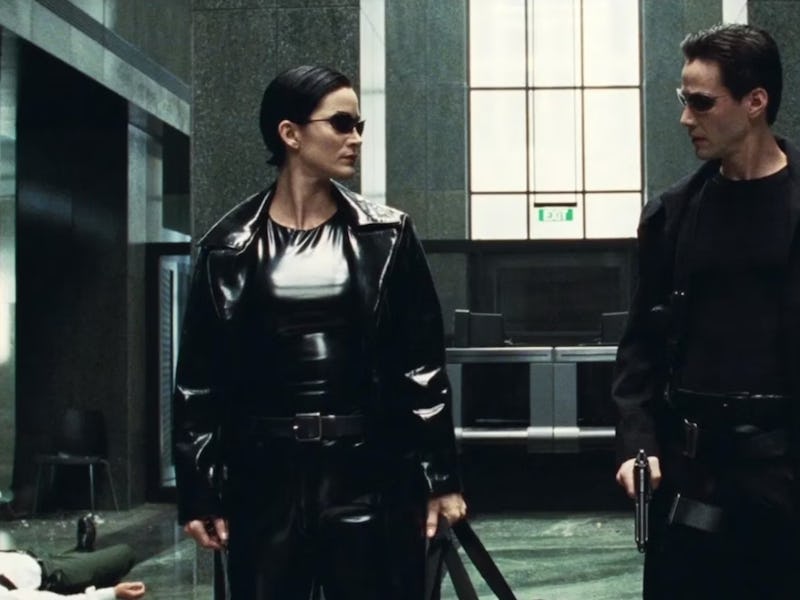25 Years Later, The Matrix Still Defines Cinematic Cool
Dust off your trenchcoat.

The Wachowskis have always worn their influences on their sleeve. Anime fans can easily recognize elements of Akira and Ghost in the Shell in The Matrix, a film that also owes credit to Blade Runner, Neuromancer, and the general miasma of cyberpunk imagery floating around sci-fi media in the 1990s. Combine that with John Woo action, kung fu cinema references, and the counterculture vibes of Vertigo’s The Invisibles, and you have a rich stew of inspirations.
This willingness to borrow and remix material is why some detractors accuse The Matrix of being a ripoff, mistaking a love of homage for a lack of creativity. It’s also what fueled The Matrix’s unique sense of cool, grabbing multiple strands of the late-’90s zeitgeist and cranking the volume up to 11.
Twenty-five years on, the Wachowskis’ ability to synthesize these influences feels more impressive than ever. Modern Hollywood is obsessed with nostalgia, churning out dozens of tiresome legacy sequels (Ghostbusters, Jurassic Park, The Exorcist) and leaning heavily into recycled 1980s vibes. The ironic, reference-filled humor of Joss Whedon and Quentin Tarantino has metastasized into something dull and commercial, weighed down by cheap callbacks to childhood faves. The Matrix’s various homages feel miraculously effective by comparison, executed with more elegance and respect for their source material. No one could ever accuse the Wachowskis of being ironic or insincere.
Like all futuristic sci-fi, The Matrix tapped into the tech and anxieties of its day: Gen-X identity crises, the birth of the internet, the bland expanse of ’90s corporate America. Its distinctive visual worldbuilding drew from contemporary fashion and anime, and its industrial soundtrack matched the cybergoth costumes of its main characters.
Designed by recurring Wachowski collaborator Kym Barrett, The Matrix’s costumes are an iconic image of Y2K style. The simplest proof of their impact is how easy it is to throw together a Neo outfit for Halloween. Trinity’s slick PVC catsuit offers more logistical issues, but if you can get your hands on a long black coat and a pair of shades, you’re all set. Matrix coats are instantly recognizable, and like anything people found cool two decades ago, they now feel corny.
Pictured: the most popular Halloween outfit of 1999.
Looking back at ’90s pop culture, you can find hints of the Matrix aesthetic everywhere from Missy Elliott videos to Star Trek: The Next Generation’s Borg, not to mention 1998’s Blade and the fantasy-noir Dark City, whose atmospheric, reality-bending setting invites obvious comparisons. As for the long black coats, they were already popular. Neo and Morpheus just brought them further into the mainstream, becoming a defining example in retrospect.
In the years following The Matrix’s release, a flood of wannabes tried to capture its style. Equilibrium (2002) put Christian Bale and Taye Diggs in tailored monochrome suits, performing “gun kata” fight sequences in a dystopian setting. The vampire-action Underworld movies had little in common with The Matrix’s deeper themes, but Kate Beckinsale’s leather-clad protagonist visibly calls back to Trinity. Then there are less well-remembered millennial outings like Ultraviolet (a sci-fi action thriller starring Milla Jovovich) and Aeon Flux (starring Charlize Theron), which rode the same wave of cyberpunk costuming, martial arts influences, and nonsensical dystopian fantasy.
None of these films measured up to The Matrix. Not just because The Matrix kickstarted the trend, but because it was so much more accomplished in terms of technical prowess and imagination.
Unlike in many knockoffs, The Matrix’s outfits served story and visual purposes.
The Wachowskis’ use of “bullet time” may be the most iconic example, but the first Matrix movie was firing on all cylinders. Unlike in the knockoff films that followed, those glossy, fetish-adjacent costumes serve multiple purposes. They reflect how the heroes want to be seen, temporarily freed from the scarcity of their post-apocalyptic home. Contrasting with the identical suits worn by the Agents, these outfits tap into the same appeal as Mad Max or The Warriors, identifying Neo and his allies as a new generation of counterculture rebels. Beyond that, there’s also a practical reason for all that leather and PVC.
Much of The Matrix takes place in the dark, embracing a black and green color palette with sharp contrasts between light and shade. The shiny fabrics provide a reflective surface, creating the right conditions for anime-inspired highlights. Neo and Trinity stand out against a neo-noir backdrop of goth clubs, rainy streets, and gleaming angular architecture, all monochrome and reflective. It’s the exact opposite of the current plague of murky, low-contrast blockbusters where you can barely see what’s happening onscreen. Instead of relying on digital color correction, The Matrix’s queasy green lighting was built into a tangible setting.
To modern viewers, much of The Matrix’s futuristic imagery now feels amusingly quaint: the vintage cell phones, the sunglasses, the ’90s hacker slang. Its dorky techno-religious philosophizing belongs to a different era. Yet as a work of cinema, it still hits just as hard as it did at the turn of the millennium, relying on pure artistry now that its particular brand of cool is firmly in the rearview mirror.